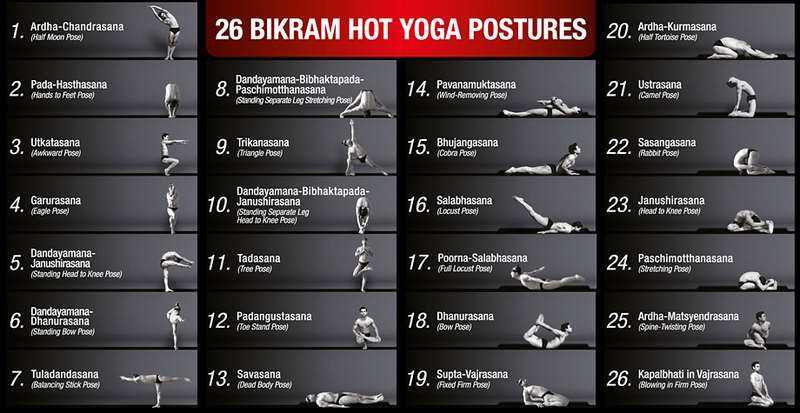Bikram is a type of yoga that was introduced by Bikram Choundury, an accomplished yogi, in the 1970’s. Bikram yoga classes consist of a series of 26 postures and 2 breathing exercises, which run for about 90 minutes.
This type of yoga is best done in a 40 °C room with a humidity of about 40 percent. The benefits of Bikram yoga include the improvement of both body and mind. However, it can also be dangerous as it can cause injuries.

Postures of Bikram Yoga
Standing Poses
There are 12 standing poses in Bikram yoga. These include the toes stand, tree, standing bow, triangle and balancing stick. These poses help strengthen and stretch the muscles in the abdomen and lower extremities. The major benefits of standing Bikram yoga are relieving arthritis and sciatica, opening the pelvic area and improving circulation.
Floor Poses
The Bikram poses performed on the floor include fixed firm, cobra series, half-tortoise, rabbit and camel. These poses help open and stretch the neck and spine. This, in turn, leads to improved function of the digestive, reproductive and central nervous systems. They also help relieve constipation, scoliosis and lower back pain.
Here is a video to guide you on the various movements of Bikram Yoga:
Benefits of Bikram Yoga
Flexibility
This is one of the most apparent benefits of Bikram Yoga. It helps improve the flexibility of your body since you get to stretch muscles and other body parts. The heat involved in this type of yoga loosens muscles and joints, allowing you to stretch beyond your limits.
Detoxification
One of the bikram yoga benefits is that the body cleanses itself through the respiratory and circulatory system. Due to the elevated humidity and room temperature, Bikram yoga accelerates the process. After all, toxins are released through the skin when you sweat. This is according to Bikram’s College of India.
Weight Loss
Bikram yoga program focuses on cardiovascular activity and strength building, which contribute a great deal towards weight loss. It is estimated that a single 90 minute session of Bikram yoga burns about 630 calories per hour. Combined with a proper dieting plan, you might be surprised by your weight.
Cardiovascular Health
Bikram Yoga helps with cardiovascular health by resting cholesterol and heart rates, retarding the growth of atherosclerosis and blood pressure. The meditation done during breathing exercises help to stabilize the lining of the blood vessels and the endothelium. Meditation also helps lower stress hormones and reduces the risk of heart attack and stroke.
General Physical Preparedness
Another benefit of Bikram yoga is that it increases General Physical Preparedness (GPP). It improves your fitness levels, recovery time, strength and metabolism. This is backed by scientific research.
Stress Relief and Mental Concentration
Bikram focuses on mindfulness, calm breathing and staying in the present. The positive feelings developed during class are fulfilling and refreshing. They help improve social well-being and create a sense of belonging. This helps with symptoms of depression, hyperactivity, sleep disorders and attention deficit.
Tips for Bikram Yoga
Stay Hydrated
Drink plenty of water through the Bikram yoga process and after wards. The high temperatures associated with this type of yoga can be dehydrating. Do not drink too much water at a time as a full stomach will interfere with your yoga poses. You can take a natural sports-drink to replenish all the sodium you will lose during a session.
Mind Your Body
Do not try too hard to complete difficult poses as you might injure yourself in the process. You need to work on finding your edge. This is the place where you are working as hard as you can, but are not pushing yourself too hard. Do not quit when you feel your muscles burn, rather when you feel dizzy or sick or when you are in pain.
What to Wear
One thing you should remember is that you want to leave as much skin as possible exposed to increase the area for sweat to evaporate. Overdressing will only hamper your flexibility and endurance.
What to Eat Before the Class
You should pay close attention to what you eat. Include fruits with high water and sodium content. Bananas and watermelon are good examples. You should also include dried fruit, nuts and seeds. However, dairy products should be avoided before a Bikram session.

View All Comments /Add Comment